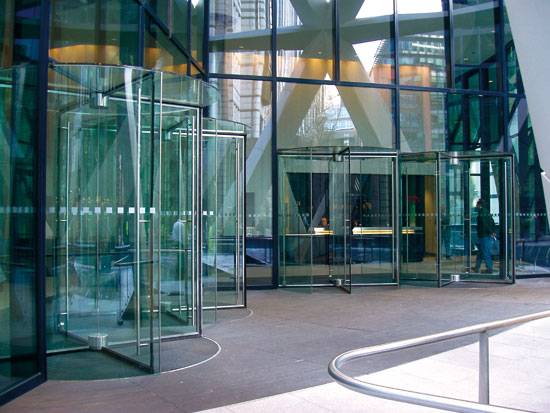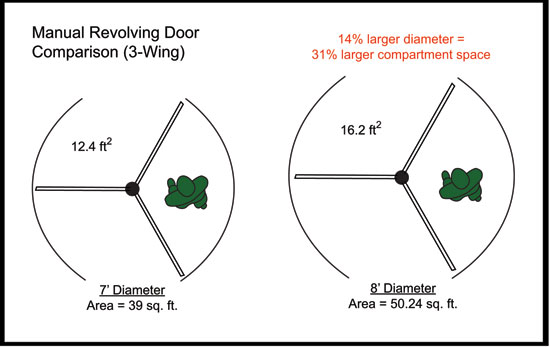The Ins and Outs of Revolving Doors
Security
Security against man-made and natural hazards is a growing concern, and entry doors are a key focus of that concern for every building owner in both public and private sectors. Most revolving door manufacturers offer a variety of night locking options that can ensure the building is securely closed during non-opening hours. Options include different types of locking mechanisms that secure the door wings in their standard, resting position and night sliding doors that close over the throat opening of the revolving door. Doors can be locked from a remote location, and access control systems can be integrated with the door to allow authorized users to unlock and enter or exit the building. Today, many employee-only entrances use security revolving doors to prevent tailgating and piggybacking, which are unauthorized, and sometimes forceful, entry via a separate compartment or in the same compartment as an authorized person, respectively. Vandal- and bullet-resistant glass is also available.

Image courtesy of Boon Edam
All-glass revolving doors are well-suited for a glass facade.
In other applications, fewer safety measures and a minimal impact may be allowable in order to improve the flow of people through the door. Manufacturers can advise on what safety measures are advisable for a specific project.
Recommended Surrounding Features
Building overhangs provide shelter from weather and keep snow and rain from getting inside the door, and are a popular strategy in colder sections of the country. However, as described earlier, interior throat opening or keyhole connections can create the same benefit within the entry itself, making for a simpler, more cost-effective solution by requiring less of an exterior overhang to be built. In addition, if access control is used, an overhang provides protection during the brief pause when a user must gain authorization prior to entering a security revolving door.
Adequate attention should also be paid to flooring. While revolving doors require the floor surface beneath them to be perfectly level to ensure proper operation, there are other considerations. Using different flooring materials for the circular area occupied by the revolving door itself visually signifies to users the actual path of the moving door wings and makes for less confusion and hesitation upon entering. The installation of the matting materials at the exterior and interior will help avoid slips and falls. Many buildings also employ stainless steel floor grates on either the exterior or interior side of the door or even under the entire door to collect dirt and debris before entry in order to decrease maintenance costs. Grating or matting that continues 10 feet or more into the interior space can also help qualify for LEED IEQ5 (Indoor chemical and pollutant source control).
Capacity and Type of Use
While the above concerns are certainly to be considered, the biggest issues in the specification of a revolving door are capacity and character of expected traffic. Obviously, the traffic expected in a small office building will be very different than that expected at an airport terminal. Architects will have to consider how many and what type of people are expected to enter and exit a facility. Will rush hours be a concern or will traffic be spread throughout the day? Will doors have to accommodate individuals with luggage or shopping carts? Are hospital gurneys an issue? Capacity is based on type of facility and user demographic. Slower capacities are generally applicable for facilities that will accommodate families, children, the elderly or the disabled, including museums, hospitals, transit systems or airports, restaurants or retail establishments and hotels and casinos. These are all situations in which users may be entering the facility for the first time and need time to adjust or get their bearings in unfamiliar surroundings. In addition, each of these user categories may be further constrained by luggage, wheelchairs, and packages and be slowed by their own or the needs of members of their group.
Optimum capacity is reserved for “trained traffic,” or users who are familiar with the doors and the building and are either residents or employees who come and go on a regular basis.
In general, small office buildings, restaurant, and high-end retail use three- or four-wing manual revolving doors. Either two- three- or four-wing automatic revolving doors are more appropriate for hotels, hospitals, airports, and large retail stores.
Capacity and User Comfort
Factors that affect capacity and user comfort are diameter of the drum, throat opening, manual or automatic operation, compartment size and number of door wings, ANSI code requirements for maximum rotation speed and safety sensors, and to some degree the positioning drive on manual revolving doors.
Traffic Type Capacity
This is expressed in terms of direction x number of people per direction per minute. For example, “1x15” refers to a one-way door that allows 15 people through in one minute, for a total of 15 people/minute. One-way doors, however, have limited application. The more typical capacity equation is “2x24,” signifying a two-way door that allows 24 people per direction in one minute for a total of 48 people/minute.
When calculating throughput, an individual's comfort zone should be considered. Most people would prefer a comfort zone around them of 4 feet diameter or 2 feet in front and back of them. The result is a circle surrounding the user that takes up about 12 square feet. To roughly gauge the capacity of a revolving door you can divide a compartment area by 12 square feet and then multiply the number of compartments by the recommended number of revolutions per minute.
Diameter
The first element that influences capacity is diameter. With automatic doors, larger diameter increases capacity. However, with manual doors, increases in diameter generally work to increase user comfort, as they are intended for one user per compartment. The heavier weight of increased diameter doors actually make the door slightly harder to push, lowering the RPMs and thus slightly decreasing the number of people that move through. It is interesting to note that when the diameter of a door is increased by a certain ratio, the area of each compartment increases by a much greater ratio. Thus, for a slightly wider opening in the building envelope, the comfort and/or the capacity can be greatly improved. Note that in the accompanying chart, for a manual three-wing door, the 7-foot diameter accommodates the minimum comfort zone of a 12-square-foot area. Yet increasing the diameter by 14 percent to 8 feet yields a 31 percent larger compartment for greatly improved comfort.
A 7-foot manual four-wing door would have a much tighter fit; in this case, a slightly larger diameter is recommended for user comfort.

Image courtesy of Boon Edam
Throat Opening
Another factor affecting capacity is the throat opening. By design, a four-wing door has a wider throat opening than a three-wing door of similar diameter. The wider throat opening is easier to pass through and therefore increases user comfort and capacity. In smaller-diameter doors, the throat opening width becomes more of an influential factor in determining capacity. In addition, smaller three-wing doors may not provide enough space in the throat opening for emergency egress which we will discuss later.
With automatic revolving doors, larger diameters translate to increased comfort and throughput. Even modest increases in diameter translate to substantially increased user comfort and capacity. Consider a 10-foot-diameter, three-wing automatic revolving door vs. a similar door of 14 feet in diameter. The larger door results in a compartment size of nearly 47 square feet, nearing 200 percent larger than the 10-foot diameter door. Using the rule of thumb of dividing each compartment size by 12 to get the number of comfortable users, the smaller door can really only manage two users, while the larger door can handle four.
The accompanying chart shows the effect of changing diameter, throat size, and compartment size on the maximum RPMs and the capacity per minute for automatic doors, showing the best way to divide the geometry of the drum for a desired throughput. In the chart, the compartment size number reflects the loss of a few feet that is taken up by the center showcase. Assuming a comfort zone of 12 square feet, the numbers shown are approximately correct, though they do not take into account the sensors on the trailing door wing which we will discuss later.

Image courtesy of Boon Edam
Manual or Automatic
Another parameter to consider in determining capacity is whether manual or automatic doors are required. Manual doors generally accommodate one person per compartment, and are most suitable for low-traffic applications. In certain circumstances such as museum exhibits, courthouses or airport terminal exits, an automatic one-way door can be used as a kind of security measure where users leave through the door but are not able to be readmitted. Cost is another factor in determining whether an automatic or manual door is selected. Building owners may prefer the lower price point coupled with the lower maintenance costs of a manual revolving door compared to the higher price and maintenance costs of an automatic door.
Compartment Size and Shape
Designers should factor in how compartment size affects wheelchair access, rolling luggage, shopping carts, and emergency egress, etc. While in general it is true that larger compartments afford more comfort or accommodate higher capacities, there may be caveats in certain situations. Also, as mentioned earlier, in comparing smaller manual doors of the same diameter, the throat opening of the four-wing is greater than that of the three-wing. The throat opening of three-wing doors under 7 feet diameter is not wide enough to meet life safety codes when the door wings are collapsed during an emergency.
ANSI code requirements
The American National Standards Institute places safety restrictions on the rotation speed of manual and automatic revolving doors and also requires presence detection sensors for automatic doors that can slow or stop the door when objects or people are close to making contact with the door. These requirements are discussed in more detail later in regard to safety however it is worth mentioning briefly here their influence on throughput.
Positioning Drive
In manual doors, an optional positioning drive system will rotate the door to the standard “X” position after use, which eliminates user confusion upon entering the door, and enables the user to step in and keep pushing rather than hesitating. These same positioning drive systems may also incorporate a power assist function which will help users push the door with reduced effort.









